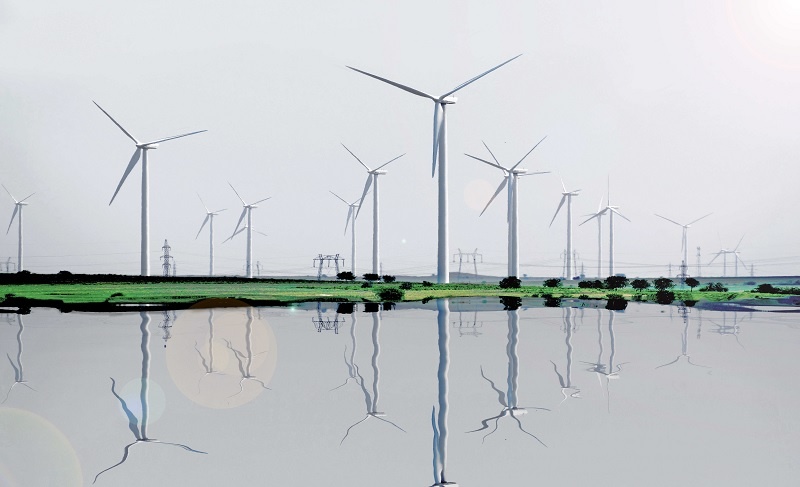Renewable energy ventures increasingly in vogue
 |
| Renewable energy ventures increasingly in vogue,- illustration photo |
At its latest extraordinary general shareholder’s meeting, PetroVietnam Technical Services Corporation (HSX: PVS) has greenlit adding offshore wind power investment to its core businesses.
The move is attuned to its development orientation in the context of the shift towards renewable energy taking hold vigorously on a global scale, and Vietnam is crafting policies towards stimulating the use of energy in a green, clean, and sustainable manner.
In past months, PVS has been serving most near-shore wind power projects in southwestern areas, including wind power turbines and towers’ transportation and installation, and underground cable landing.
The company has also been engaged in the long-term supply of specialised ships for the transportation of manpower and equipment for operation and maintenance for Binh Dai-Ben Tre wind power project, and Tra Vinh wind power project.
Tan Viet Securities’ (TVSI) recent analytical report noted that as per the latest version of Power Development Plan VIII (PDP8), Vietnam strongly encourages renewable energy (besides hydropower) development, raising the proportion of renewable energy in the total estimated capacity from 27 per cent in 2021 to 29 per cent in 2025 and over 40 per cent by 2045.
The move aligns with development trends worldwide as well as global emission reduction commitments.
TVSI cited an example that real estate firm Ha Do Group (HSX: HDG) enjoys good potential in the medium and long term for renewable energy development. In 2021, HDG brought into exploitation its 7A wind power project and two other hydropower plants, bringing the total combined capacity of its power plants from 245MW to 462MW.
TVSI estimates that by 2030, HDG’s renewable energy count would account for 2-5 per cent of the country’s total renewable energy capacity.
Assuming that the annual revenue growth in renewable energy averaged 20 per cent, TVSI estimates that from 2023 the energy segment would contribute more than VND1 trillion ($43.47 million) in profit to HDG annually.
The Refrigeration Electrical Engineering Corporation (HSX: REE) has also made several wind power ventures. The company currently possesses 126MW wind power and 86MW rooftop solar power capacity. REE is expected to soon revive its revenue and profit figures leveraging completed renewable energy contracts.
Similarly, major underground work contractor FECON JSC (HSX: FCN), aside from its traditional infrastructure investment segment, is scaling up investment into renewable energy with a string of wind and solar power projects in the south, central, and Central Highlands regions.
This year, the company envisages splashing VND1.22 trillion ($53 million) into renewable energy and urban infrastructure projects.
Agribank Securities JSC has presented bright prospects for renewable energy tickers in 2022. One positive factor behind the assessment is a sharp decline in the net cost of renewable energy projects’ life cycle thanks to tech applications and price competition among turbine and solar battery suppliers worldwide.
The installation cost of solar power and ground-based wind power projects is expected to be even cheaper than that of coal-fired power projects in the forthcoming time when the equipment market has come to saturation point.
According to a World Bank forecast, Vietnam would be producing 5-10GW offshore wind power capacity by 2030, creating about $60 billion in total added value for the economy.
Leveraging strong wind power sources, the country’s offshore wind power generation has an efficiency of over 50 per cent, similar to that of hydroelectricity. The technologies for offshore wind power projects are being innovated at a quicker pace than those applicable to other energy sources.
In a meeting seeking comments to perfect PDP8 in last November, presided over by Deputy Prime Minister Le Van Thanh, many proposals were voiced for the building of a more sustainable power source structure.
The updated PDP8 draft has featured key changes compared to the March 2021 draft. Accordingly, coal-fired power share was slightly reduced from 26.7 per cent in the March draft to 25.49 per cent in the November draft; that of gas-fired power from 9.9 per cent to 9.49 per cent, respectively. Meanwhile ground-based wind power share has slightly increased from 10.7 per cent in March to 11.13 per cent in the November draft, and that of offshore wind power from 2 per cent to 2.57
per cent.
The share of renewable energy (excluding hydropower) would reach 24.3 per cent of the system’s total installed capacity, equal to 31,600MW by 2030 from the current 17,000MW.
What the stars mean:
★ Poor ★ ★ Promising ★★★ Good ★★★★ Very good ★★★★★ Exceptional
Related Contents
Latest News
More News
- TCP Group partner with VNUS to launch water conservation project (December 25, 2025 | 14:00)
- Heavy industries set for pilot greenhouse gas quotas (December 25, 2025 | 10:00)
- Swedfund invests in MSME growth and climate action in Vietnam (December 19, 2025 | 11:42)
- GreenYellow brings solar energy to light up remote schools in Tuyen Quang province (December 19, 2025 | 08:00)
- Charge+, Grab partner to develop EV charging network in Vietnam (December 18, 2025 | 17:11)
- Linking sci-tech and innovation to Vietnam’s net-zero future (December 18, 2025 | 14:31)
- Driving double-digit growth through green and circular transformation in Vietnam (December 17, 2025 | 09:00)
- Standard Chartered and ACCA deepen collaboration to develop Vietnam’s talent for a sustainable future (December 15, 2025 | 18:18)
- Schaeffler reports strong early output from Dong Nai solar project (December 12, 2025 | 15:16)
- Forestry conference highlights biodiversity and sustainability goals (December 09, 2025 | 13:35)

 Tag:
Tag:



















 Mobile Version
Mobile Version